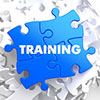Move Your Company Forward With a Strong Employee Development Strategy

Is your employee training program strong or half-hearted? If the latter is true, that could be as bad as having no program at all, if not worse. A well-developed training program for your employees is integral to your company’s success. If you’re not focusing on training, you may want to rethink your priorities.
When you view employee training as essential, it becomes easier to devote the time and resources necessary to make the effort worthwhile. When employees see that you want to make them more valuable to the company, and that they’re worth investing in, they generally become more engaged, motivated and committed to organizational success.
They’re also more likely to anticipate eventual promotions and financial rewards for their newly acquired skills and the ability to assume greater responsibility. The alternative to a robust training strategy is almost always bringing in new talent from the outside to meet the need for more skilled labor — a costly proposition.
Review Goals
Building a training strategy begins with a review of your organization’s intermediate and long-term goals. You might be starting with financial targets, but achieving them will require accomplishing some other underlying objectives. Examples could include improving customer satisfaction, lengthening product life, increasing labor productivity, expanding your product line, winning more patents, diversifying your customer base and so on.
With those goals clearly articulated, you’ll need to focus on the “human capital” implications by answering questions such as:
- What kinds of employees will we need — right away, and over longer periods of time — to achieve those goals?
- What skills gaps do we have today that are impeding our progress?
- Which employees and departments should be our top training priority? Where are the gaps the greatest?
- What are the best methods of building the expertise and skills we need?
Present and future required capabilities will probably run the gamut, from very narrow technical proficiencies to harder-to-measure qualities like creativity, problem-solving and leadership. It’s important to distinguish between current and future needs, and to establish a timetable for satisfying them.
In addition, you’ll need to identify particular employees who show the greatest potential for development in the areas of need. Sit down with these highly valued employees and ask them about their own ambitions and development needs as they perceive them. You might address their points with a formal training program, a mentorship program or a combination of the two.
Query Employees
Ideally, these discussion topics would be incorporated into routine performance review conversations. Even so, having a fresh and more detailed review of development needs — particularly for high-potential employees — can be productive. Basic questions include:
- Do you feel fully equipped to do the job we expect you to do?
- If not, what training do you need?
- Where would you like to see yourself with this company in three years? Five years? Ten?
- What skills do you believe you’ll need to achieve those career goals?
- How much of your time after hours are you willing to devote to such training?
One approach is to work with the employee to create an individual development plan. Just be sure to manage expectations to avoid any implication that completing the plan is a guarantee of a particular job or status in the future. Similarly, incorporate performance metrics so that employee and supervisor are on the same page about what needs to be achieved.
Identify Gaps
To ensure that your training strategy is implemented comprehensively and systematically, create a “training matrix.” This is a spreadsheet listing all employees covered by the program on a vertical axis, and development steps and training modules on the horizontal axis. Target completion dates should be included for each training unit. As the matrix is routinely updated, you’ll have a snapshot view of progress.
The training matrix may reveal that internal resources are inadequate to meet the needs you have identified. Some employees you had high hopes for might prove disappointing, or leave. But it’s better to know that early on.
Employees who get used to the idea that they’ll need to update and build their skills as a routine job requirement might be the most flexible and have the greatest growth potential. For this reason, it makes sense to incorporate some form of training into your employee onboarding program. Even the most promising new employees are bound to lack some knowledge or skills that will make them 100% productive right off the bat.
Finally, just as you should talk to employees to get their perspective on their training needs, don’t neglect to get their feedback on the training programs in which they participate. People have different learning styles, and you can generally find training modules and methods that accommodate these variations.
There’s always room for improvement, and employees will appreciate the respect that’s indicated when you ask for their opinions.




